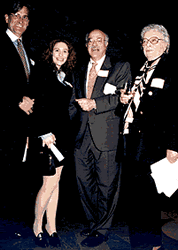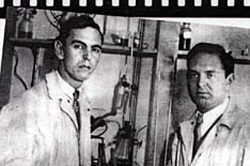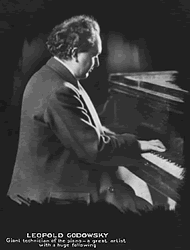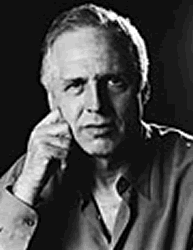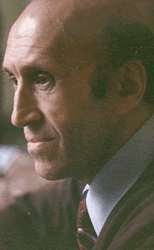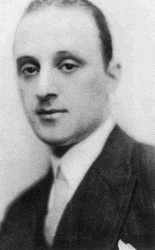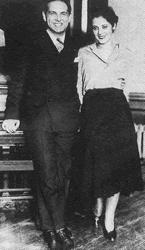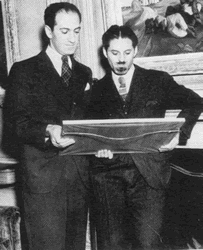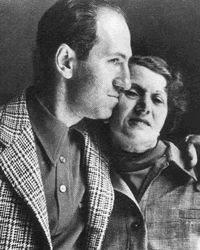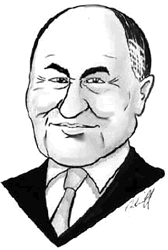Godowsky is a composer, a pianist, and also the nephew of George and Ira Gershwin
#grswn-11:
The Generous Landlord
of Greenwich Village
by Rene MartinoÂ
"PAPA STRUNSKY"
This is the story of Albert Strunsky,
a Russian immigrant who became
a landlord in the Village and also the
archetype for the landlord who forsakes
rent for the brotherhood of his tenants.
Dr. Henrietta Stoner remembers Strunsky.
"Strunsky was a character,",
recalls Stoner, a former Strunsky tenant. "But he was the most
wonderful man in the world. If you could not pay the rent, he'd settle
for a radio, for a painting if you were an artist and he liked your
work. But there was more to him than just that....
in 1991, Lenore Strunsky Gershwin, the widow of Ira Gershwin, died at
90.
MICHAEL S. STRUNSKY
Vice President, Airport Commission
Educated at Cornell University in Electrical Engineering and Columbia
University in Construction Management, Michael S. Strunsky, Chairman
and Chief Executive Officer of Apersey, has more than thirty-eight years
of experience in all phases of construction. He began his career with
the New York Port Authority as Construction Engineer on a number of
major projects, including Kennedy International Airport. From there
he went to work for progressively larger construction firms, such as
Morse/Diesel and Bechtel, assuming increasing levels of responsibility.
Founder, Chairman and Chief Executive Officer of Apersey Construction
since 1978, Mr. Strunsky has utilized his experience and expertise to
the service of Apersey clients. Mr. Strunsky holds a California contractor's
license.
Mr. Strunsky is also sole Trustee and Executor of the Ira Gershwin Musical
Estate.
Mr. Strunsky was first appointed to the Airport Commission by Mayor
Frank Jordan on November 3, 1993. He was reappointed by Mayor Willie
L. Brown, Jr. on December 8, 1997, and again on September 2, 2001. His
term expires on August 31, 2005.
----the stewards of the estate include younger brother Arthur's son,
Marc, and his son Adam; younger sister Frances' son Leopold; and Michael
Strunsky, the nephew of Ira's wife; along with attorneys and artistic
and executive advisors. Now, 63 years after Gershwin's sudden death
at the age of 38, the trustees of his estate have finally given someone
permission to create the role of their esteemed ancestor for the commercial
stage----- Noah Gershwin, son of George's great-nephew Adam.....
for the entire article go to;
http://www.jrep.com/Arts/Article-24.html
Radiology of the Arthritides: A Clinical Perspective
By Adam Eric Gershwin, Adam Greenspan
Hardcover  / January 1990 Â
/Â 0397446756
Title:Â Â Â Â Â Â We The People
Log Line: A romantic comedy set in a summer camp amongst two opposing
"sides of the fence"--the rich campers and the local campers.
Writer:Â Â Â Adam Gershwin and Amy Sale of Gershwin
Agent:Â Â Â Dino Carlafter/ The Agency
Studio:Â Â Touchstone Pictures
Price:Â Â Â Â Â Mid-six figures
Genre:Â Â Â Comedy
Logged:Â Â 2/24/98
More:Â Â Â Â Â part of a two-pitch sale
for this husband-and-wife writing team.
Title:Â Â Â Â Â Â Untitled Walt
Disney Picture
Log Line: Story about a female agent in the IRS who has to bring down
a New York Millionaire.
Writer:Â Â Â Adam Gershwin and Amy Salesin Gershwin
Agent:Â Â Â Dino Carlafter/ The Agency
Studio:Â Â Walt Disney Pictures
Price:Â Â Â Â Mid-six figures
Genre:Â Â Comedy
Logged:Â 2/24/98
More:Â Â Â Â Part of a two-pitch deal for this
husband-and-wife writing team.
Scored For: Piano/Vocal/Chords
Publisher: Warner Brothers
Father in law of Frances nee Gershwin; Leopold Godowsky (1870-1938) from Jeremy Nicholas' "Godowsky - The Pianists' Pianist"
Godowsky was born on 13 February 1870, the only child of Anna and Matthew Godowsky, in Sozly , a little town not far from Vilna, the ancient capital of Lithuania. His father, a respected physician, died in a cholera epidemic only eighteen months after his son's birth. With barely enough money for food and lodgings, Anna and her infant son moved to nearby Schirwinty and thence, at the invitation of her friends Louis and Minna Passinock, to Wilno. Louis's consuming passion was music - a fine amateur violinist who ran a piano shop - and, having no children of his own, set about teaching young Leopold the violin in the hope that he might turn him into a second Paganini. Though his pupil was soon proficient enough to have mastered the solo part of Mendelssohn's Violin Concerto in E minor it was to the piano that he was instinctively drawn, despite being actively discouraged at first.
-------At five years old Godowsky composed his first piece, a minuet. "The middle section was a perfect canon. This is noteworthy because up to that time I had never heard a canon. I used this canon in another composition twenty-three years later." Godowsky made his first public appearance at the age of nine in Wilno, and soon afterwards, under the enthusiastic auspices of his adopted father Louis Passinock, made his first tour as a piano wunderkind. -----
The 11 year-old Godowsky quickly made a name for himself (and his adoptive father some much needed money). His playing came to the attention of a banker named Feinberg. Realizing that the boy was in a fair way to being exploited, he arranged for Godowsky to take the examination for the Berlin High School for Music. Godowsky played for a panel who included Moritz Moszkowski, Woldemar Bargiel (Schumann's brother-in-law) and the director of the performance department of the Academy, the great violinist Joseph Joachim. Godowsky was accepted and, financed by Feinberg, began his studies under Ernst Rudorff. After a mere three months, he had had enough. "My mother wrote more than usual and with a note of loneliness and motherly anxiousness which she always knew how to conceal." His 'Aunt' Minna had died, 'Uncle' Louis missed him...the 13 year old Godowsky packed his bags, met his mother and 'uncle' at the station and caught the train to Hamburg. In November 1884, they arrived in America. Godowsky made his debut there on 7 December in Boston as a member of the Clara Louise Kellogg Company. Early in 1885 he made a series of appearances at the New York Casino, alternating with Teresa Carreño. Soon afterwards, he embarked on an extended tour with the violinist Ovide Musin, who had heard him as a wunderkind in Wilno. Godowsky was eventually left stranded and penniless in the West and somehow struggled back to New York.From 1886, both his mother and Louis Passinock faded from Godowsky's life. Passinock's fate is unknown and all we know of Anna Godowsky is that she died shortly before the First World War (she and her son had retained a nominal contact). But not for the first time, the young prodigy was taken up by a wealthy patron of the arts, one who was to have a lasting effect on Godowsky's life, Leon Saxe. Back in New York after his desolate return from the West Coast, Godowsky was introduced to the Saxes and their six children and was welcomed as another son. Here he also found romance in the shape of the Saxes' young daughter Frederica (known as Frieda). Saxe offered to take Godowsky back to Europe and to Weimar to study with Franz Liszt, the most famous and charismatic musician in the world. In July 1886, Godowsky set sail for France with his new 'uncle', Leon Saxe, who would spend most of the next four years with him in Europe. (Mrs. Saxe was eventually sent for, leaving her six children behind her!) Liszt, alas, died on 31 July, within days of Godowsky's arrival in France. Saxe and his young charge instead made for Paris - and Camille Saint-Saëns. Saint-Saëns did no regular teaching but, once again, Godowsky's phenomenal ability won him special consideration. Having played for the great man, it was agreed that Godowsky would come and play for him whenever he wanted. For a time, the two met up every Sunday. Saint-Saëns seemed to believe that Godowsky had been sent by Providence to replace the son he had lost so tragically...... Six months after his return to America, Godowsky gave a Carnegie Hall recital, one of the first pianists to play there - on 24 April, two weeks before the hall officially opened. On 30 April he married his childhood sweetheart Frieda Saxe and the next day became an American citizen. Concert .....
his daughters Vanita (born 1894) and Dagmar (born 1898), son Leopold Junior (born 1900) son Gutram (later anglicized to Gordon) was born in 1906.....
.....Vanita had married in 1924 (her husband, the concert pianist David Saperton, was to become the teacher of Abbey Simon, Jorge Bolet and Shura Cherkassky). Dagmar was enjoying her social life, in the midst of one of her two marriages and subsequent divorces. Leopold Junior had met an attractive, lively singer named Frances ('Frankie'), the sister of George and Ira Gershwin. Gordon, abandoned his English literature studies at Harvard to marry a vaudeville dancer. Godowsky was furious and disowned him.------ In December 1932, Gordon Godowsky killed himself by gas. Frieda Godowsky's frail health disintegrated. (Dagmar wrote, "I never saw her smile again.") Barely a year later, she succumbed to a heart attack in the Godowsky apartment at the Hotel Ansonia, New York-----
After Frieda's death, Godowsky moved to an apartment with Dagmar on Riverside Drive overlooking the Hudson----
---For much of 1937 he was confined to bed with heart trouble and gout. He died of stomach cancer at 7 a.m. on Monday 21 November 1938. He was 68. He was buried in Temple Israel Cemetery, with Frieda and Gordon. Tributes came from all over the world. An editorial in the New York Times (in addition to his obituary) illustrates the regard in which he was held at the time of his death
For the entire article go to http://www.godowsky.com/Biography/bio.html
TWO OF THE MOST remarkable,
improbable and least-known Jewish inventors of the 20th century, were
a pair of Jewish-American musicians --- Leopold Mannes and Leopold Godowsky,
Jr. (in law of the Gershwins), affectionately nicknamed by their colleagues,
"Man" and "G-d." Although they were both highly skilled,
professional, classical musicians, and scions of well-known performing
families, their inventions had nothing to do with music. Mannes and Godowsky
were the primary inventors of color photography as we know it today. The
original Kodachrome, Ektachrome, Kodacolor, and Ektacolor film processes
were all products of their collective genius. ....
http://www.jewishworldreview.com/0398/geduld1.html
Name Birth Date Birth Place City/County State Ethnicity
Godowsky, Alexander 15 Aug 1881 relative lives Riga Russia New Castle
DE W
Godowsky, Frances nee Gershwin 1906-1999
Biography Index. A cumulative index to biographical material in
books and magazines. Volume 24: September, 1998-August, 1999. New
York: H. W. Wilson Co., 1999.(BioIn 24)
Biography Index. A cumulative index to biographical material in
books and magazines. Volume 26: September, 2000-August, 2001. New
York: H. W. Wilson Co., 2001.(BioIn 26)
1570267
Godowsky, Leopold 1870-1938
The Heritage Encyclopedia of Band Music. Composers and their music.
Supplement. By William H. Rehrig. Westerville, OH: Integrity Press,
1996.(HeriEBM SUP) Godowsky, Leopold Jr. 1900-1983
Biography Index. A cumulative index to biographical material in
books and magazines. Volume 3: September, 1952-August, 1955. New
York: H.W. Wilson Co., 1956.(BioIn 3)
Biography Index. A cumulative index to biographical material in
books and magazines. Volume 4: September, 1955-August, 1958. New
York: H.W. Wilson Co., 1960.(BioIn 4)
Biography Index. A cumulative index to biographical material in
books and magazines. Volume 11: September, 1976-August, 1979. New
York: H.W. Wilson Co., 1980.(BioIn 11)
Godowsky, Dagmar died in 1975
Who's Who in Hollywood. The largest cast of international film
personalities ever assembled. Two volumes. By David Ragan. New York:
Facts on File, 1992.(WhoHol 1992)
Godowsky, Barry Martin 1950-
Who's Who in Finance and Industry. 28th edition, 1994-1995. New
Providence, NJ: Marquis Who's Who, 1993.(WhoFI 28)
Frank
Godowsky AgeWith12ths('49',false);49 BirthYear(1930, '49');1880 Poland
Head Negro Bristol, Hartford, CT Sophie Godowsky AgeWith12ths('6',false);6
BirthYear(1930, '6');1923 Wife Bristol, Hartford, CT Anthony Godowsky
AgeWith12ths('11',false);11 BirthYear(1930, '11');1918 Son Bristol, Hartford,
CT Alice Godowsky AgeWith12ths('10',false);10 BirthYear(1930, '10');1919
Daughter Bristol, Hartford, CT Joseph Godowsky AgeWith12ths('45',false);45
BirthYear(1930, '45');1884 Poland Head White Stonington, New London, CT
Rafalina Godowsky AgeWith12ths('38',false);38 BirthYear(1930, '38');1891
Wife Stonington, New London, CT Domich Godowsky AgeWith12ths('18',false);18
BirthYear(1930, '18');1911 Son Stonington, New London, CT Aleck Godowsky
AgeWith12ths('16',false);16 BirthYear(1930, '16');1913 Son Stonington,
New London, CT Sadie Godowsky AgeWith12ths('8',false);8 BirthYear(1930,
'8');1921 Daughter Stonington, New London, CT Yvonne Godowsky AgeWith12ths('27',false);27
BirthYear(1930, '27');1902 Pennsylvania Guest White Miami Beach, Dade,
FL Max Godowsky AgeWith12ths('48',false);48 BirthYear(1930, '48');1881
Russia Head White Chicago, Cook, IL Anna Godowsky AgeWith12ths('46',false);46
BirthYear(1930, '46');1883 Wife Chicago, Cook, IL Bertha Godowsky AgeWith12ths('24',false);24
BirthYear(1930, '24');1905 Daughter Chicago, Cook, IL Betsy Godowsky AgeWith12ths('21',false);21
BirthYear(1930, '21');1908 Daughter
(City,County,State) View
Census?
Godowsky, Anna 24 BirthYear(1920, '24');1895 Illinois White Chicago, Cook,
Illinois
Godowsky, Rudolf 45 BirthYear(1920, '45');1874 Poland White Macomb, McDonough,
Illinois
Godowsky, Samuel 39 BirthYear(1920, '39');1880 Russia White Philadelphia,
Philadelphia, Pennsylvania
Chicago, Cook, IL Samuel Godowsky AgeWith12ths('56',false);56 BirthYear(1930,
'56');1873 Russia Head White Atlantic City, Atlantic, NJ Esther Godowsky
AgeWith12ths('52',false);52 BirthYear(1930, '52');1877 Wife Atlantic City,
Atlantic, NJ Max Godowsky AgeWith12ths('22',false);22 BirthYear(1930,
'22');1907 Son Atlantic City, Atlantic, NJ -----------------------------------
Leo Godowsky Age With12ths('29',false);29 BirthYear(1930, '29');1900
Illinois Head White Manhattan, New York, NY Gordon Godowsky Age With12ths('24',false);24
BirthYear(1930, '24');1905 Brother Manhattan, New York, NY --------------------------------
Anna Godowsky Age With12ths('25',false);25 BirthYear(1930, '25');1904
United States of America Lodger White Manhattan, New York, NY Record
ALICE
GODOWSKY 28 Nov 1914 Oct 1966 Wilmington, New Castle, DE NJ (Before
1951 ) 150-09-0345
BESSIE GODOWSKY 3 May 1911 Nov 1978 Paterson, Passaic, NJ NJ (Before 1951
) 135-16-5166
D GODOWSKY 8 Oct 1948 Oct 1988 NJ (1964 ) 143-40-1911
DAGMAR GODOWSKY born; 24 Nov 1897died; Feb 1975 New York,
New York, NY NY (1954 And 1955 ) 074-30-1297
FRANCES GODOWSKY (nee Gershwin) born; 6 Dec 1906 died; 18 Jan 1999 New
York, New York, NY CT (1963 ) 046-38-4920
HARRIET GODOWSKY 18 Feb 1919
May 1986 Sun City West, Maricopa, AZ OH (Before 1951 ) 296-01-0987
IDA GODOWSKY 18 Jun 1898 Aug 1978 Atlantic City, Atlantic, NJ NJ (1972
) 138-54-1277
LEOPOLD GODOWSKY born; 27 May 1900 died; Feb 1983 New York, New
York, NY NY (Before 1951 ) 073-09-9992
LOUIS GODOWSKY 10 Oct 1895 Oct 1977 Atlantic City, Atlantic, NJ NJ (1952
And 1953 ) 135-28-5880
LOUIS J GODOWSKY 2 Sep 1909 30 Apr 1999 Passaic, Passaic, NJ NJ (Before
1951 ) 158-07-2138
MARY GODOWSKY 25 Jan 1899 Nov 1966 Brooklyn, Kings, NY NY (1951 ) 113-26-2617
MAX GODOWSKY 26 Mar 1914 Jul 1977 Claymont, New Castle, DE NJ (Before
1951 ) 138-03-5025
MILDRED G GODOWSKY 16 Feb 1922 2 Aug 1996 NJ (Before 1951 ) 143-12-6156
ROBERT GODOWSKY 10 Apr 1938 Apr 1981 PA (1955 And 1957 ) 206-30-4579
ROSE GODOWSKY 15 Mar 1883 May 1968 Philadelphia, Philadelphia, PA PA (1962
) 187-36-3287
THEODORE GODOWSKY 3 Nov 1911 19 Dec 1989 Paterson, Passaic, NJ NY (Before
1951 ) 113-03-3210
WALTER GODOWSKY 1 Mar 1942 May 1975 Virginia Beach, Virginia Beach City,
VA NJ (1956 And 1957 ) 156-30-4182
WALTER GODOWSKY 31 Jan 1920 Aug 1966 NJ (Before 1951 ) 157-09-2270 ---
Library Opens New Gershwin Room with Symposium ----The Library's Music
Division celebrated the March 17 opening of the new George and Ira Gershwin
Room -- located across the hall from the Jefferson Building's Coolidge
Auditorium -- with a March 13-16 event that explored "The Gershwins
and Their World"-----
---In the audience were English Strunsky (trustee of the Ira and Leonore
Gershwin Trusts) and wife Lucy; son Michael Strunsky (also a trustee)
and wife Jean; and Leopold Godowsky III
(son of Frances Gershwin). Mr. ------Newsom also acknowledged Rose Gershwin
(George and Ira's mother); Arthur (brother of George and Ira) and wife
Judy; Marc George Gershwin (their son); and Elaine Godowsky, wife of Leopold.-----
---- This was my Aunt Lee's
dream," said Michael Strunsky, using Leonore's nickname. "The
American people will now get to see things [in the newly opened Gershwin
Room] that have been mostly family possessions. It's a more-than-moving
experience to see her dream come to fruition
This was my Aunt Lee's dream," said Michael Strunsky, using Leonore's
nickname. "The American people will now get to see things [in the
newly opened Gershwin Room] that have been mostly family possessions.
It's a more-than-moving experience to see her dream come to fruition
http://www.loc.gov/loc/lcib/9804/gershwin.html
Godowsky is a composer, a pianist, and also the nephew of George and Ira
Gershwin.
This year, in honor of the 100th anniversary of the birth of George Gershwin,
Godowsky performed his Concerto in F at Lincoln Center's Alice Tully Hall
last February and again in November with the Wallingford Symphony Orchestra
at the Paul Mellon Arts Center. Chicago Tribune music critic Howard Reich
says, "Pianist Godowsky...offers one of the most romantic
and heartfelt performances of the Concerto in F in the last three decades."
"The family connection is not a secret," Godowsky says, "but
I've always been very shy about taking advantage of it."
The Concerto in F, which Godowsky ranks with Porgy and Bess as among Gershwin's
most important works, is unique in the way it combines jazz and the more
classical elements of music. Accepting an invitation to perform at Lincoln
Center, Godowsky learned the second and third movements in three months--a
short time for such a demanding piece--and without listening to other
recordings because he wanted to interpret the music for himself. What
makes his performance amazing is that Godowsky is dyslexic. He began to
study piano at the age of five, but, unable to read music, he played mostly
by ear. In his later teens, when "music meant more to me than anything,"
Godowsky compensated for this then-unrecognized problem and strengthened
his sight-reading ability through sheer repetition and practice.
Despite his dyslexia, Godowsky has always had a "very good feel for
science and mathematics," both of which have a close connection to
music. His own compositions are based on themes and motifs, and there
is a sense of relevance in his music. He describes his a cappella oratorio
Jonah, based on the Biblical story, as having "tempestuous music
for the storm and slithery music for the worm. God speaks as a vocal quartet--very
pure and beautiful." His music also has a lot of variety: "It's
very structured and contrapuntal. I like to explore different emotions
and use different harmonies and dissonances." In his score for the
film of Isaac Bashevis Singer's short story, "The Cafeteria,"
he composed two themes-one for each of the two main characters--that are
treated in many different ways.
In addition to his famous uncles, Godowsky has other talented and creative
family members. He is the grandson of Leopold Godowsky, Sr., the pianist
and composer. His father, a concert violinist, was also a chemist and
co-inventor of the Kodachrome process. Frances Gershwin Godowsky, his
mother, is a painter and sculptor. Godowsky's strong sense of visual imagery
is expressed through his music, as in his brass quintet based on the triptych
panels of Hieronymus Bosch's Garden of Earthly Delights.....
At
Choate, Godowsky received what he calls his "real education"--the
discipline of how to learn and the acquisition of his writing skills.
He went on to receive bachelor's and master's degrees from Columbia University
and then spent a number of years playing and teaching piano. At the age
of 40 he decided to compose. In typical fashion, he began by challenging
himself-his first majorwork was a string quartet, arguably the most difficult
music to write....
Name: Morris Gerahevin
[Morris Gershwin]
Home in 1920: Manhattan Assembly District 21, New York, New York
Age: 47 years
Estimated birth year: abt 1873
Birthplace: Russia
Relation to Head of House: Head
Spouse's name: Rose
Father's Birth Place: Russia
Mother's Birth Place: Russia
Marital Status: Married
Race: White
Sex: Male
Home owned: Rent
Year of Immigration: 1893
Able to read: Yes
Able to Write: Yes
Image: 202
Neighbors: View others on page
Household Members: Name Age
Morris Gerahevin 47
Rose Gerahevin 39
Isadore Gerahevin 23
George Gerahevin 21
Arthur Gerahevin 19
-------------------
1910 census;
Name: Morris Gershvem
[Morris Gershwin]
[Morris Gershvein]
Age in 1910: 38
Estimated birth year: abt 1872
Birthplace: Russia
Relation to Head of House: Head
Father's Birth Place: Russia
Mother's Birth Place: Russia
Spouse's name: Rose
Home in 1910: Manhattan Ward 10, New York, New York
Marital Status: Married
Race: White
Gender: Male
Year of Immigration: 1891
Neighbors: View others on page
Household Members: Name Age
Morris Gershvem 38
Rose Gershvem 32
George Gershvem 11
Isidor Gershvem 13
